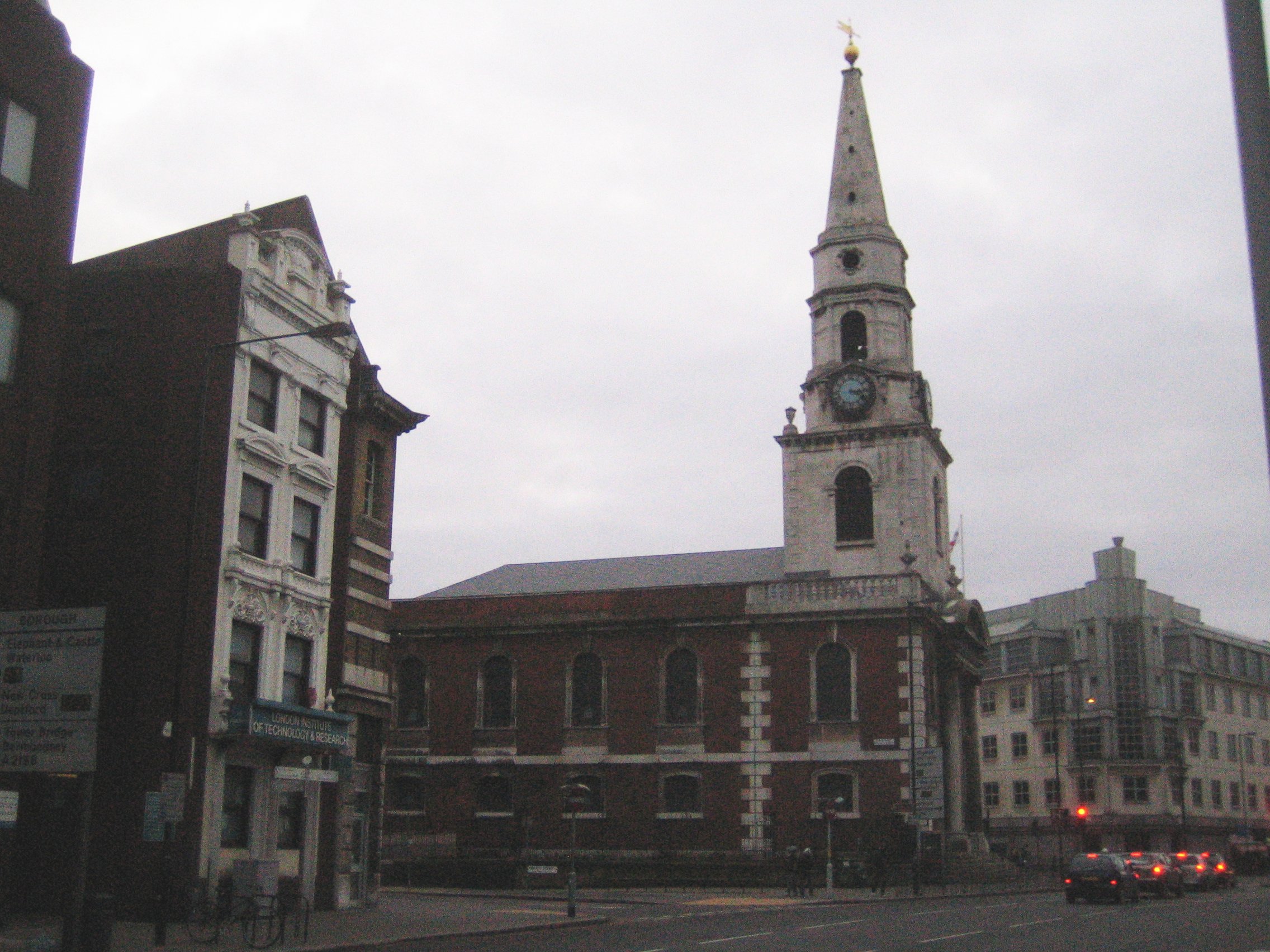- St George the Martyr Southwark
Infobox church
name = St. George the Martyr
fullname =
color =

imagesize =
caption = Photo of St. George the Martyr
landscape =
denomination =Church of England , earlierRoman Catholic
diocese =
parish =
division =
subdivision =
founded_date =
founder =
architect =
style =
constructed_date =
dedicated_date =
closed_date =
demolished_date =
bishop =
priest =
archdeacon =
dean =
provost =
rector =
canon =
prebendary =
curate =
chaplain =
vicar =
deacon =
abbot =
minister =
seniorpastor =
pastor =
address =The Borough ,London Borough of Southwark
country =United Kingdom
phone =
website =St George the Martyr is a church in the historic Borough district of south
London . It lies within the modern dayLondon Borough of Southwark . St George the Martyr is named afterSaint George . According to traditionalhagiography , the saint served as a soldier in theRoman Army and was killed on the orders of the emperorDiocletian in 303 for refusing to persecute Christians and confessing to his own Christianity. The earliest reference to this church is in the Annals of Bermondsey Abbey, which claims that the church was given by Thomas de Ardern and Thomas his son in 1122. The date follows the Battle of Acre when the St George myth became adopted by English crusaders; perhaps the church dedication is related to the Arderns involvement in the Crusade. This gift included tithes from their manor at Horndon in Essex and "land of London Bridge returning five solidos". This statement means that this St George's is the first and the oldest church with this dedication in the present London area and it predates Edward III's adoption of George as the patron of the Garter by over 200 years. The statement is also the first reference to London Bridge's endowment lands. The present priest was nominated by the City's Bridge House Estates.On Henry V's return from the battle of Agincourt in 1415 he was welcomed by the Aldermen of London on the steps of the church. The 'Agincourt Song' was commissioned as part of the celebration. In this battle the standard with the red cross was used for the first time. In the same year St George became the patron saint of England
The west tower dominates views along
Borough High Street from both the north and south due to the curve in the street at this point, where it now meetsGreat Dover Street . Originally, a much narrower road to the south of the church called Church Street led into Kent Street (now renamed Tabard Street), the historic route toDover . Due to the volume of traffic, Great Dover Street was cut through parallel to Kent Street in the early nineteenth century. Tabard Street was subsequently extended through the churchyard on the north side of the church, leaving the church on an island site.The present church is believed to be the third on this site. There was a Norman church of unknown appearance. This was replaced at the end of the fourteenth century by a church with a bell tower, which may have been from where Antonin de Wyngaerde surveyed at least part of his plan view of London, which includes a drawing of the church, but slightly out of position as might occur if drawn onto the perspective latterly. The church also appears to be that in
William Hogarth 's engraving of "Southwark Fair" made in 1733, a year before it was demolished. The church was rebuilt in a Classical style to the designs of John Price between 1734 and 1736, partly funded by £6,000 from theCommission for Building Fifty New Churches . The major City Livery Companies and the Bridge House Estates also supported this rebuilding, their arms decorate the nave ceiling and stained glass.The red brick and
Portland Stone structure of the church has suffered from considerablesubsidence damage, and the nave was declared unsafe in 2000, although services continued in other parts of the building. In September 2005, St. George the Martyr received funding via the [http://www.hlf.org.uk/English/ Heritage Lottery Fund] for repairs and refurbishments, which involve completeunderpinning of the building, and the lowering of the floor levels in the crypt to create additional space. A large number of lead Georgian coffins were removed from the crypt to allow the works to take place. Subsequent archaeological investigations of the ground beneath the church found substantial Medieval and Roman structures. The destruction of some archaeological remains before a fuller excavation could be completed led to controversy. [ [http://arts.guardian.co.uk/news/story/0,,1786849,00.html Roman remains face obliteration at Southwark site | | Guardian Unlimited Arts ] ]The church was closed for restoration works between September 2005 and March 2007. During this time the congregation worshipped at nearby Guy's Chapel. The new 'crypt', in fact a church hall created by the underpinning works, provides a new conference venue in central London.
Services at St George's resumed on
Palm Sunday 1 April 2007 . [ [http://www.london-se1.co.uk/news/view/2641 St George the Martyr church reopens [1 April 2007 ] ] The present priest in charge is Rev Ray Andrews.The church has strong associations with
Charles Dickens , whose father was imprisoned for debt in theMarshalsea prison. The surviving wall of the prison adjoins the north side of the churchyard. Dickens himself lived nearby, in Lant Street, lodging in a house that belonged to the Vestry Clerk of St George's. This was during the darkest period of his life when, as a teenager, with his father in prison, he had to work in the 'blacking factory', and his literary career must have seemed an impossible dream. Later, he was to set several scenes of the novel "Little Dorrit " in and around St George's Church. There is a small representation of Little Dorrit in the east window of the church.Footnotes
ee also
*
List of churches and cathedrals of London Geo links
*Coord|51.501255|-0.092582|type:landmark_region:GB_source:wikimapia|display=inline
*Coord|51|30|14|N|0|5|32|W|type:landmark|region:GB_source:no-source|display=title,inline
Wikimedia Foundation. 2010.
